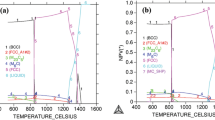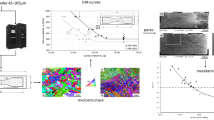Abstract
In this article, we study the influence of the cubic boron nitride (CBN) particle size in nano/micro CBN particle-coated tools on the fatigue performance of hard-machined AISI 1053 steel. The effect of the CBN particle size on the crack initiation life and the crack propagation life is reduced significantly with increased loading, whereas the crack propagation life is more influenced by the CBN particle size compared with the crack initiation life. The CBN particle size can influence the crack initiation life by 96 % and the crack propagation life by 130 %. As a result, it can influence the fatigue life by 370 % at the maximum Hertzian stress of 2,724 MPa. The results demonstrate that the CBN particle size influences the fatigue life and that the effect of the CBN particle size on the fatigue life can be lessened significantly if the loading is increased to a certain level that depends on the function of machined surfaces.















Similar content being viewed by others
References
Choi, Y.: A study on the effects of machining-induced residual stress on rolling contact fatigue. Int. J. Fatigue 31, 1517–1523 (2009)
Li, J.L., **g, L.L., Chen, M.: An FEM study on residual stresses induced by high-speed end-milling of hardened steel SKD11. J. Mater. Process. Technol. 209, 4515–4520 (2009)
Li, W., Withers, P.J., Axinte, D., Preuss, M., Andrews, P.: Residual stresses in face finish turning of high strength nickel-based superalloy. J. Mater. Process. Technol. 209, 4896–4902 (2009)
Taraf, M., Zahaf, E.H., Oussouaddi, O., Zeghloul, A.: Numerical analysis for predicting the rolling contact fatigue crack initiation in a railway wheel steel. Tribol. Int. 43, 585–593 (2010)
Lammi, C.J., Lados, D.A.: Effects of residual stresses on fatigue crack growth behavior of structural materials: analytical corrections. Int. J. Fatigue 33, 858–867 (2011)
Warhadpande, A., Sadeghi, F.: Effects of surface defects on rolling contact fatigue of heavily loaded lubricated contacts. Proc. Inst. Mech. Eng. Part J. 224, 1061–1077 (2010)
Pattabiraman, S., Levesque, G., Kim, N.H., Arakere, N.K.: Uncertainty analysis for rolling contact fatigue failure probability of silicon nitride ball bearings. Int. J. Solids Struct. 47, 2543–2553 (2010)
Dirks, B., Enblom, R.: Prediction model for wheel profile wear and rolling contact fatigue. Wear 271, 210–217 (2011)
Hai, G.X., Diao, H.X., **g, H.R., Hua, W., Jie, C.: A rolling contact fatigue reliability evaluation method and its application to a slewing bearing. J. Tribol. 134, 011101 (2012)
Shimatani, Y., Shiozawa, K., Nakada, T., Yoshimoto, T., Lu, L.: The effect of the residual stresses generated by surface-finishing methods on the very high cycle fatigue behaviour of matrix HSS. Int. J. Fatigue 33, 122–131 (2011)
Waikar, R.A., Guo, Y.B.: An experimental study on the effect of machining induced white layer on frictional and wear performance at dry and lubricated sliding contact. Tribol. Trans. 53, 127–136 (2010)
Attanasio, A., Umbrello, D., Cappellini, C., Rotella, G., M’Saoubi, R.: Tool wear effects on white and dark layer formation in hard turning of AISI 52100 steel. Wear (2011). doi:10.1016/j.wear.2011.07.001
Russell, W.C., Malshe, A.P., Yedave, S.N., Brown, W.D.: CBN-TiN composite coating using a novel combinatorial method-Structure and performance in metal cutting. J. Manuf. Sci. Eng. 125, 431–435 (2003)
Halpin, T., Byrne, G., Barry, J.: The performance of PCBN in hard turning. Ind. Diamond Rev. 65, 52–60 (2005)
Tamizharasan, T., Selvaraj, T., Noorul Haq, A.: Analysis of tool wear and surface finish in hard turning. Int. J. Adv. Manuf. Technol. 28, 671–679 (2006)
Davies, M.A., Chou, Y., Evans, C.J.: On chip morphology, tool wear, and cutting mechanics in finish hard turning. CIRP Ann. 45, 77–82 (1996)
Hooper, R.M., Shakib, J.I., Brookes, C.A.: Microstructure and wear of Tic-Cubic BN tools. Mater. Sci. Eng. 429–433 (1988)
Chou, Y.: Wear mechanism of cubic boron nitride tools in precision turning of hardened steels. Ph.D. thesis, Purdue University (1994)
Chou, Y., Barash, M.M.: Review on hard turning and CBN cutting tools. SME Technical Paper, 1–12 (1995)
Chou, Y.K., Evans, C.J.: Cubic born nitride tool wear in interrupted hard cutting. Wear 229, 234–245 (1999)
Nakkiew, W.: The effect of micro/nano particle size on the thermal, tribological properties and the performances of coated composite tools. Ph.D. thesis, Purdue University (2010)
Agha, S.R.: Fatigue performance of superfinish hard turned surfaces in rolling contact. Ph.D. thesis, Purdue University (2000)
Choi, Y.: Modeling and analysis of rolling contact fatigue life and spall progression life of superfinish hard machined surfaces. Ph.D. thesis, Purdue University (2006)
Noyan, I.C., Cohen, J.B.: Residual stress: measurement by diffraction and interpretation. Springer, New York (1987)
Choi, Y., Liu, C.R.: Rolling contact fatigue life of finish hard machined surfaces: Part 1. Model development. Wear 261, 485–491 (2006)
Choi, Y., Liu, C.R.: Rolling contact fatigue life of finish hard machined surfaces: Part 2. Experimental verification. Wear 261, 492–499 (2006)
Liu, C.R., Choi, Y.: A new methodology for predicting crack initiation life for rolling contact fatigue based on dislocation and crack propagation. Int. J. Mech. Sci. 50, 117–123 (2008)
Tanaka, K., Mura, T.: Dislocation model for fatigue crack initiation. J. Appl. Mech. 48, 97–103 (1981)
Kaynak, C., Ankara, A., Baker, T.J.: Initiation and early growth of short fatigue cracks at inclusions. Mater. Sci. Technol. 12, 421–426 (1996)
Melander, A.: A finite element study of short cracks with different inclusion types under rolling contact fatigue load. Int. J. Fatigue 19, 13–24 (1997)
Nelias, D., Dumont, M.L., Champiot, F., Vincent, A., Girodin, D., Fougeres, R., Flamand, L.: Role of inclusions, surface roughness and operating conditions on rolling contact fatigue. J. Tribol. 121, 240–251 (1999)
Harris, T.A.: Rolling bearing analysis. Wiley, New York (2001)
Wang, Q.Y., Bathias, C., Awagoishi, N., Chen, Q.: Effect of inclusion on subsurface crack initiation and gigacycle fatigue strength. Int. J. Fatigue 24, 1269–1274 (2002)
Leng, X., Chen, Q., Shao, E.: Initiation and propagation of case crushing cracks in rolling contact fatigue. Wear 122, 33–43 (1988)
Johnson, K.L.: Contact mechanics. Cambridge University Press, Cambridge (1985)
Paris, P., Erdogan, F.: A critical analysis of crack propagation laws. J. Basic Eng. 528–534 (1963)
Chen, Q., Leng, X., Shao, E.: Influence of microstructure and residual stress on the stages of case crushing. Wear 122, 45–55 (1988)
Choi, Y., Liu, C.R.: Spall progression life model for rolling contact verified by finish hard machined surfaces. Wear 262, 24–35 (2007)
Author information
Authors and Affiliations
Corresponding author
Rights and permissions
About this article
Cite this article
Choi, Y. Influence of Nano/Micro CBN Particle-Coated Tools on Rolling Contact Fatigue Performance of Hard-Machined AISI 1053 Steel. Tribol Lett 46, 273–284 (2012). https://doi.org/10.1007/s11249-012-9949-0
Received:
Accepted:
Published:
Issue Date:
DOI: https://doi.org/10.1007/s11249-012-9949-0




